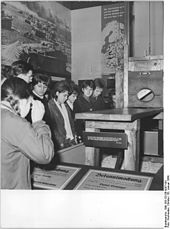Museum of German History

The Museum of German History (MfDG) was the central historical museum of the GDR . It existed from 1952 to 1990.
founding
The plans for a historical museum already existed when the GDR was founded. The official establishment goes back to the 7th plenum of the Central Committee of the SED . On October 20, 1951, this demanded the establishment of a museum for German history. The aim should be to "educate the population and especially the youth."
The institution was founded on January 18, 1952. The first exhibition opened on July 5, 1952, initially in the building of the former business school at Clara-Zetkin-Straße 26, although the arsenal in East Berlin , which is being reconstructed , was intended as a museum location. The museum moved there after its completion and was opened in March 1953.
Permanent exhibition
The permanent exhibition was essentially created in the 1950s. At times, 85 historians, curators and conservators were busy setting up the exhibition. All function and department heads belonged to the SED. The exhibition was designed under great time pressure. On the opening day, only the time until 1848 was ready, the rest followed until 1953.
The museum interpreted German history in the sense of a Marxist historical science as the history of class struggles . German history was divided into seven sections. It showed texts and objects from the “ primitive society ”, the time of feudalism , the period from 1789 to 1917, the years 1917–1945 to the “socialist fatherland GDR.” The focus was on the general history of the German labor movement . Ultimately, the view of history led to the establishment of the GDR as a "socialist republic" as the goal of German history. However, the exhibition continued to adhere to an all-German claim. The collection comprised several 100,000 exhibits. Towards the end of the 1960s, the main exhibition was only slightly adapted to the changed time conditions. Even after the renovation in the early 1980s, the basic character of the exhibition was retained. In 1981 the part "from prehistory to liberation from fascism" and in 1984 the part on the history of the GDR was presented anew.
The museum also included a Lenin memorial in memory of Lenin's stays in Berlin.
Special exhibitions
In addition, the museum showed changing special exhibitions. Large exhibitions were opened on the occasion of the Karl Marx year 1953, on the topic of "German City in the Middle Ages" in 1956, or on the 10th anniversary of the GDR in 1959. This was followed by exhibitions in 1973 on the "Storm Year 1848" and 1975 on the anniversary of the German Peasant War . Other special exhibitions were "Weapons and Uniforms of History" on the occasion of the return of the confiscated weapons stocks by the Soviet Union or "WI Lenin and the German labor movement."
The special exhibitions were supposed to have an even stronger political effect than the permanent exhibition in the interests of the GDR leadership. Up until the 1970s, the special exhibitions focused on the presentation of progressive traditions throughout Germany. Since the 1980s, a more “internationalist” perspective has increased. This interpreted the German history in connection with the international development of socialism . The 1983 exhibition " Martin Luther and his time" was significant for the change in the image of history in the GDR, including to non-socialist aspects .
By 1987, 95 special exhibitions had been designed. In addition, 107 special exhibitions were developed for abroad and 140 traveling exhibitions that were shown in the GDR and abroad were put together.
management
The first director of the museum was Alfred Meusel . He was followed by Walter Nimtz from 1963 to 1967 . Afterwards Wolfgang Herbst headed the museum. All belonged to the SED. A scientific council should ensure that the exhibition is always based on the Marxist-Leninist view of history.
The end
After the fall of the Wall , the museum was closed in 1990 by decision of the GDR Council of Ministers . The holdings were transferred to the German Historical Museum , which also took over the armory as its headquarters.
literature
- Ilko-Sascha Kowalczuk : Legitimation of a new state. Party workers on the historical front. History in the Soviet Zone / GDR 1945–1961. Links, Berlin 1997, ISBN 3-86153-130-5 , p. 175 ff.
- Stefan Ebenfeld: History according to plan? The instrumentalization of historical studies in the GDR using the example of the Museum of German History in Berlin (1950–1955). Tectum, Marburg 2001, ISBN 3-8288-8261-7 .
- Museum of German History. In: Hartmut Zimmermann: GDR manual. Verlag Wissenschaft und Politik, Cologne 1985, Vol. 2, p. 919.
- David E. Marshall: The Museum of German History - A Study of the Presentation of History in the Former German Democratic Republic. Peter Lang, New York 2010, ISBN 0-8204-7274-3 ( Studies in Modern European History. Vol. 56).
Web links
- Official website
- The Museum of German History (digitized version of the museum guide, 3rd edition, 1987)
- Ideology on display - the exhibitions of the Museum of German History 1952-1990 . In: Kulturstiftung-des-Bundes.de
- Museum of German History - in use from 1952 . In: DHM.de
- Postcard pictures from the Museum of German History . In: GDR Postcard Museum
- Rolf Lautenschläger: History completely cleared away . In: Die Tageszeitung , May 26, 2009
Individual evidence
- ↑ Detlef Brunner, Udo Grashoff and Andreas Kötzing (eds.): Asymmetrically championed? New research on the post-war history of Germany as a whole , Berlin 2013, ISBN 978-3-86153-748-9 , p. 23
- ^ Regina Müller: Das Berliner Zeughaus, Die Baugeschichte , Berlin 1994, ISBN 3-89488-055-4 , p. 282
